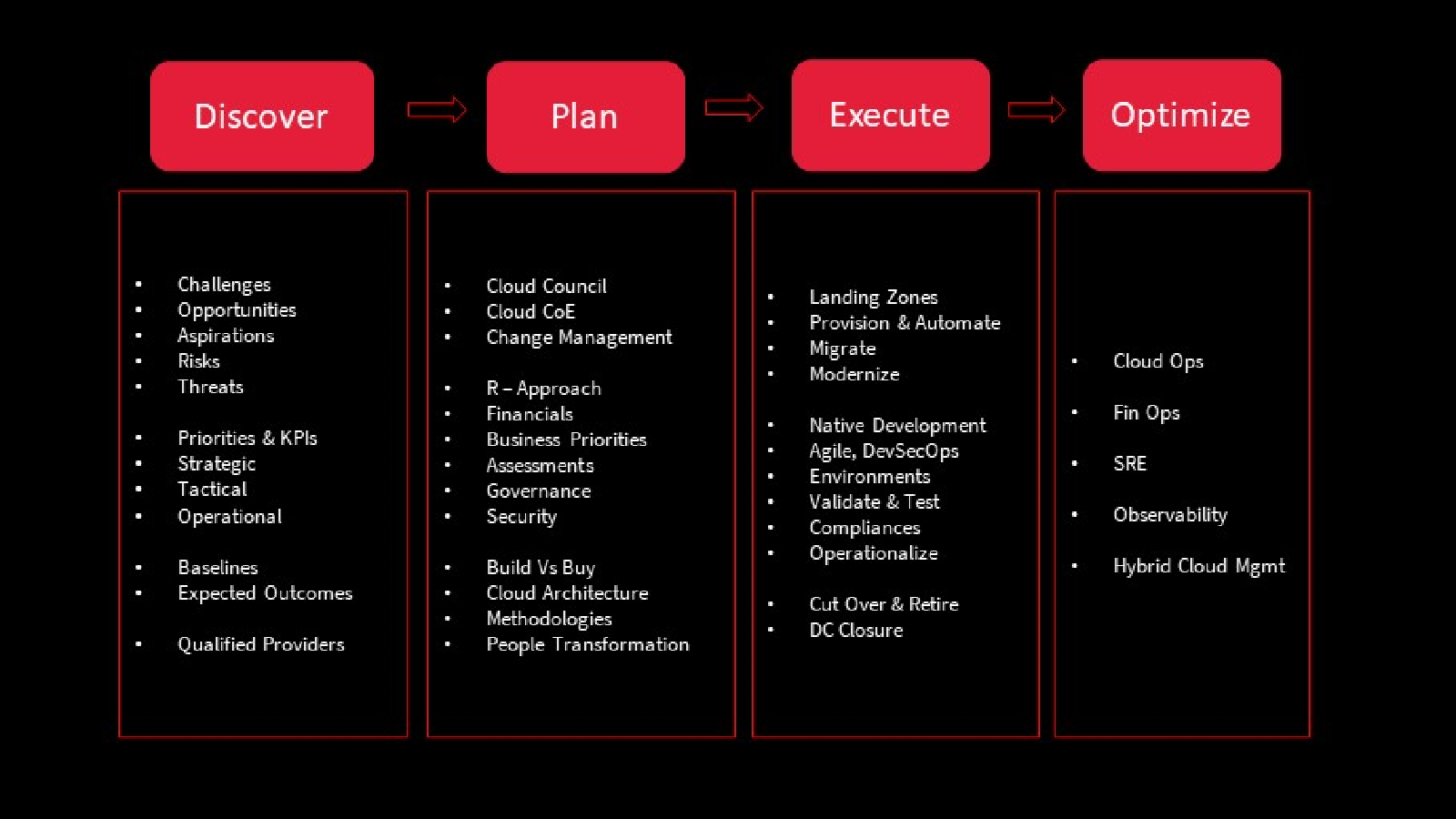Getting started with Cloud Adoption – The Why, What, and How?
Over the years, with technology advances and the realization of benefits, “Cloud Computing” has become all pervasive. The cloud phenomenon started picking up about a decade back. With companies looking for options to transform their IT infrastructure - scalability, elasticity, resource pooling and sharing, measuring and metering, on demand access to configurable computing resources with the ability to rapidly provision and deploy were some of the key expectations. Over a period of time, scope expanded beyond data centers and IT infrastructure to include networks, applications, and services.
In 2021, almost every CIO/CXO had cloud in their top priority list. As we step into 2022, coverage will continue to grow and adoption will speed up.
However, irrespective of the stage of cloud adoption one is in, there are several pertinent questions organizations are trying to find answers to. Here are some of the most compelling thoughts for CXOs.
- Will movement to cloud be really useful? How will I measure the benefits?
- There are budget constraints. How do I optimize the returns on my current investments and those planned for cloud adoption?
- What should be my hyper scaler strategy?
- How would cloud adoption help me transform my business models to fuel growth?
- Cloud is not just about Infra. It is about modernization, transformation of people, process, and business. How do I manage the change?
- What is needed to make cloud transformation sustainable?
It is important for any organization to have clarity on following aspects to have a relevant business case and a lot more streamlined, predictable cloud adoption journey
- Why should we adopt cloud?
- What should be the strategy to achieve the business objectives through cloud adoption?
- How should the strategy get executed?
A consultative approach to learn from industry best practices and business trends will enable the creation of a more business relevant cloud strategy. Retrospective, introspective, and extrospective analysis at regular intervals will help course correct.
The Why?
Different stakeholders within the organization would have different reasons for them wanting to embrace the cloud. For a software engineer, an urge to be on the right side of the technology hype curve could be a trigger. For an infrastructure manager, the need to crash the timelines required to procure IT infrastructure could be the key problem to address. For an operations manager, the ability of infrastructure to dynamically scale vertically and horizontally to adapt the changing load patterns could be a challenge to address. For a CXO, the need to drive business volumes and profitability would be the key aspiration.
While all these challenges can be addressed by the adoption of cloud, from an organization perspective, all these drivers and many more can be summarized under the following three distinct categories
1. Optimize Cost Structure
For organizations to invest in new offerings and to modernize their existing revenue channels or to optimize their operating margins, it is imperative for them to restructure their existing spending. Cloud services can be considered to re-imagine existing data centers, IT and network infrastructure assets, application development methodologies, and associated business processes. Migrating such workloads to cloud and de-commissioning existing infra could free up some cash over a period of time to be invested in growth initiatives. Extent of improvement in operating margins and cash re-purposed would depend on the current state and longevity of the data center assets.
Organizations that have scaled over a period of time through inorganic acquisitions and federated structures are likely to have a higher number of redundant systems. In turn, having an even greater opportunity to rationalize and improve their spend structure. For one of the large telecom services provider in America, generating savings by retiring and consolidating data centers was the primary business case for cloud adoption.
2. Modernize Existing Revenue Streams
With digital enablement, spurt in the service providers and pandemic enforced needs have significantly influenced customer needs, behavior, and decision patterns. Be it content viewing over OTT platform, the network bandwidth delivered by their broadband service providers, the options available through their preferred online merchant sites, or the speed at which supply chain and logistic chain delivers – customers are looking for more and better. More content, no latency, higher network speeds, faster response times, more self-service options, and a lot better customer experience (CX). Tolerance towards lower quality of services has gone down and so has the time taken for an associated customer churn.
Given such a scenario, it is important for organizations to re-evaluate their product and service portfolio, CX they are generating, customer retention, and ARPU they are resulting into. Many organizations are investing in process mining to assess their current processes, service offerings, and impact on CX. These findings are a key input to formulate their organization strategy to deliver better CX and secure their existing revenue streams. Cloud based services are being leveraged to increase digital and cognitive quotient of the organizations.
Re-architecting existing legacy and monolith systems, simplifying IT stacks, resolving performance bottlenecks, redoing user interfaces to make them a lot more simpler and intuitive, deploying self-service and bot features, including analytics and recommendation experiences and many more are the strategies organizations are looking at to modernize their existing revenue streams. Public cloud hyper scalers like Azure, AWS, GCP, IBM, Oracle, and others have a bouquet of services and marketplace to simplify and accelerate adoption of many of these capabilities.
One of the largest telecom service providers in Europe has decided to transform their entire mainframe based legacy system to improve the experience of their services. For another telecom service provider in Canada, optimizing the cost structure from their current data centers and IT systems was not the primary case. Instead, they decided to prioritize their spend on modernizing their revenue streams and developing cloud-native solutions.
3. Generate New Revenue Streams
The phenomenon that primarily started as a cost optimization initiative has evolved into a key enabler to grow business. With services related to analytics, AI, computer vision, geolocation, containers, caching, notifications, mobility, so on, it has become possible to have newer business models delivering more and better services to the customers. Simplicity and agility offered by the cloud hyper scalers enable accelerated development and market rollout of the services.
For one of the large size telecom service providers in the ASEAN region, optimizing current spend is one of the business drivers. The key business driver for adopting cloud was to increase annual revenue by about a billion dollars. This would mean new engagement models, different service offerings to not only direct customers, but also to indirect customers.
Another telecom service provider in the Middle East decided to use public cloud services to build and deploy a sales channel for their network products
What is Your Business Driver for Cloud Adoption?
While all three business drivers mentioned above are relevant, it is important for organizations to decide what is their primary business driver? At least for the next 18-24 months.
CXOs and boards are wanting to explore cloud for their business. A lot more thoughtful identification of the business objectives they want to achieve through cloud capabilities will enable them in formulating a right business case, determining a more favorable cloud strategy to achieve objectives, and in choosing the right SI partner to execute the strategy.
Of course, cloud adoption is a journey. The relevance of business drivers will need to be re-evaluated regularly to plan the next set of cloud initiatives.
The What?
Next logical question organizations need to determine is what should be their cloud strategy based on the business drivers and expected outcomes.
Which cloud hyper scaler is more suited to partner with? Whether to go with one public cloud provider or should it be a hybrid-multi cloud approach? Should SaaS and other specialized cloud providers be considered? What workloads should be considered for cloudification and how should they be prioritized? How should regulatory compliance be adhered to? What are the current baselines? What outcomes to measure and monitor? What are the fundamental design principles to be adhered to as an organization embraces cloud-based transformation? What should be the strategic, tactical, and operational priorities and associated KPIs? How to make this cloud adoption journey a lot more sustainable?
Many more compelling aspects need to be evaluated to define the right strategy and structure.
A detailed discovery phase assessing the current set of IT and business processes, service offerings, opportunities, risks, challenges should be undertaken to detail out the cloud strategy.
The How?
With the overall strategy defined, next step would be to determine how the strategy needs to be executed. This would start with setting up the center of excellence and cloud council. They will be accountable for defining the finer details of the cloud landing zones and its integration with existing data centers, networks. Cloud center of excellence (CCoE) and the associated cloud team would determine workload specific strategy and migration/development plans. Based on the estimated cost for cloud adoption and associated business case, they would also determine the final disposition on R-Strategy for respective workloads. The team would need to be deployed to execute the migration of workloads and/or to develop new systems using cloud-native services.
Subsequently, how would cloud based systems get operationalized to avoid any adverse business impacts? How would one keep a track of the spend on cloud services and have a sustainable practice to implement FinOps, CloudOps, SRE, and observability practices?
Cloud Adoption Approach
A four phased approach can facilitate organizations in address different phases of their cloud adoption roadmap.

Each item in this list needs a detailed assessment, execution to increase chances of success of the cloud adoption.
Cloud: The NXT sustainable solution
Cloud is one of the key disruptors to business and how CX is delivered. While there is peer competitive pressure and a sense of urgency to adopt cloud services, it is important for organizations to spend efforts and identify “their very own and contextual” right business driver and to have a thought- through strategy to adopt cloud. Quality efforts spent in defining the strategy and detailed planning would help optimize the spend, channelize it timely and correctly, maximize returns on the investment. System integrators having global experience in business, technology, and cloud adoption can facilitate businesses to adopt and fast track their cloud adoption journey. With appropriate architecture frameworks and design practices; by focusing on the optimal design of Infra, application, and data; by having dynamic scaling strategies; by having continual monitoring of cost and utilization of cloud assets; and by implementing compliances related to privacy and security, one can have cloud based transformation experience a lot more Seamless and Sustainable!!










